Vegetable Korma
Vegetable korma is a rich and creamy Indian curry loaded with warm spices and tender veggies. It’s absolutely decadent and divine!
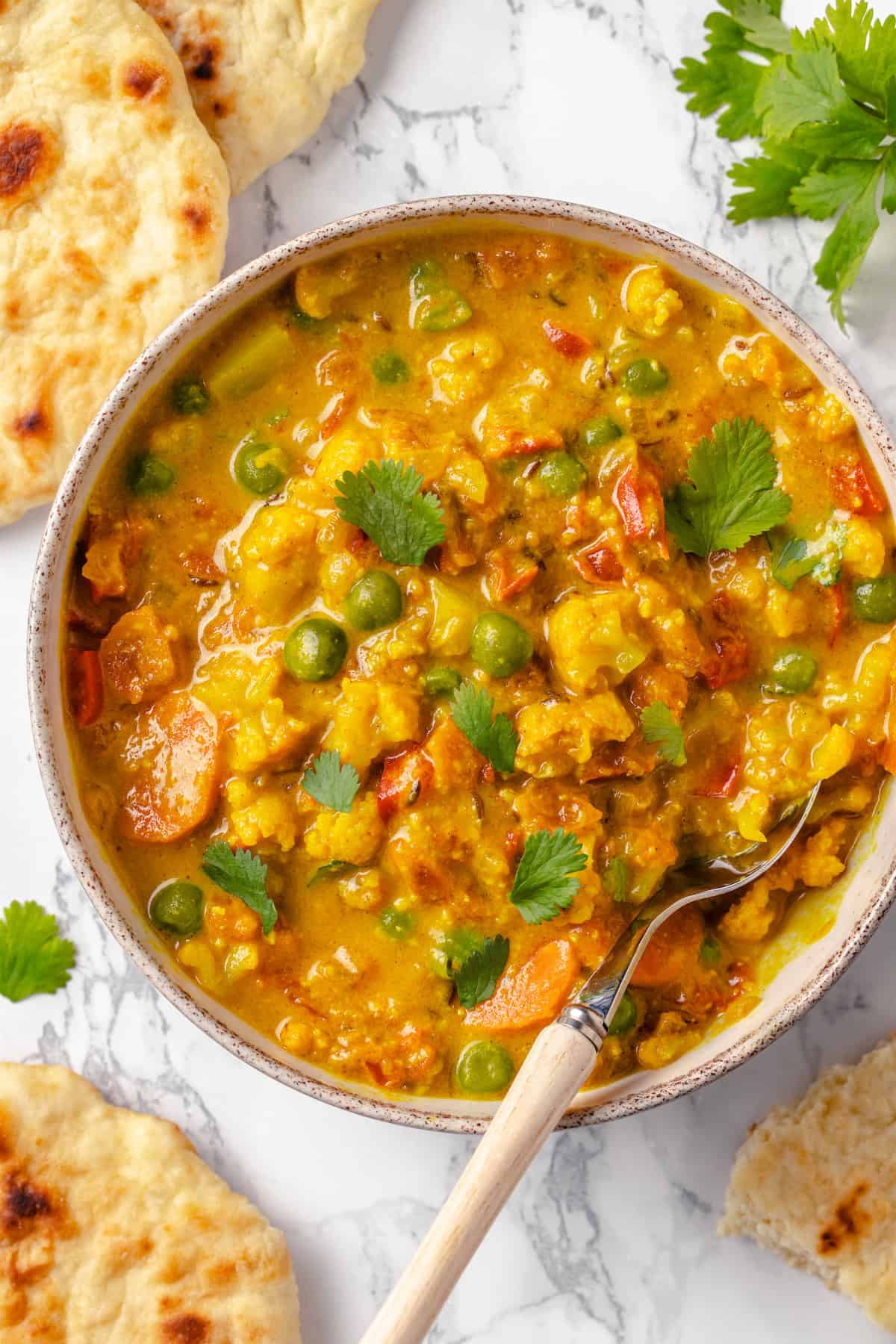
The number of Indian curry recipes in the world seems endless, but vegetable korma is among my absolute favourites. The base is rich and creamy, which not only makes it delicious, but also tempers the heat a bit. (Being Jamaican, I love a kick of heat, but I know not everyone appreciates it!) It’s loaded with aromatic spices, the vegetables cook until they’re meltingly tender, and you will want to sop up every last bit with vegan naan. It’s easy to see why korma is often served for special occasions!
Why You’ll Love This Vegetable Korma Recipe
- Rich and creamy. It’s the creamy sauce that makes korma a standout; sometimes it’s made with yogurt or heavy cream, but other times it’s made with coconut milk, which is what I’ve used here since that makes the recipe naturally vegan.
- Packed with flavor. The blend of aromatic spices adds depth and complexity to the dish, and the variety of vegetables also brings a lot of flavour to the mix.
- Versatile. Speaking of the veggies! There’s a lot of them here and you can omit one and use extra of another you like more, or switch things up with whatever you have on hand. This recipe is flexible like that.
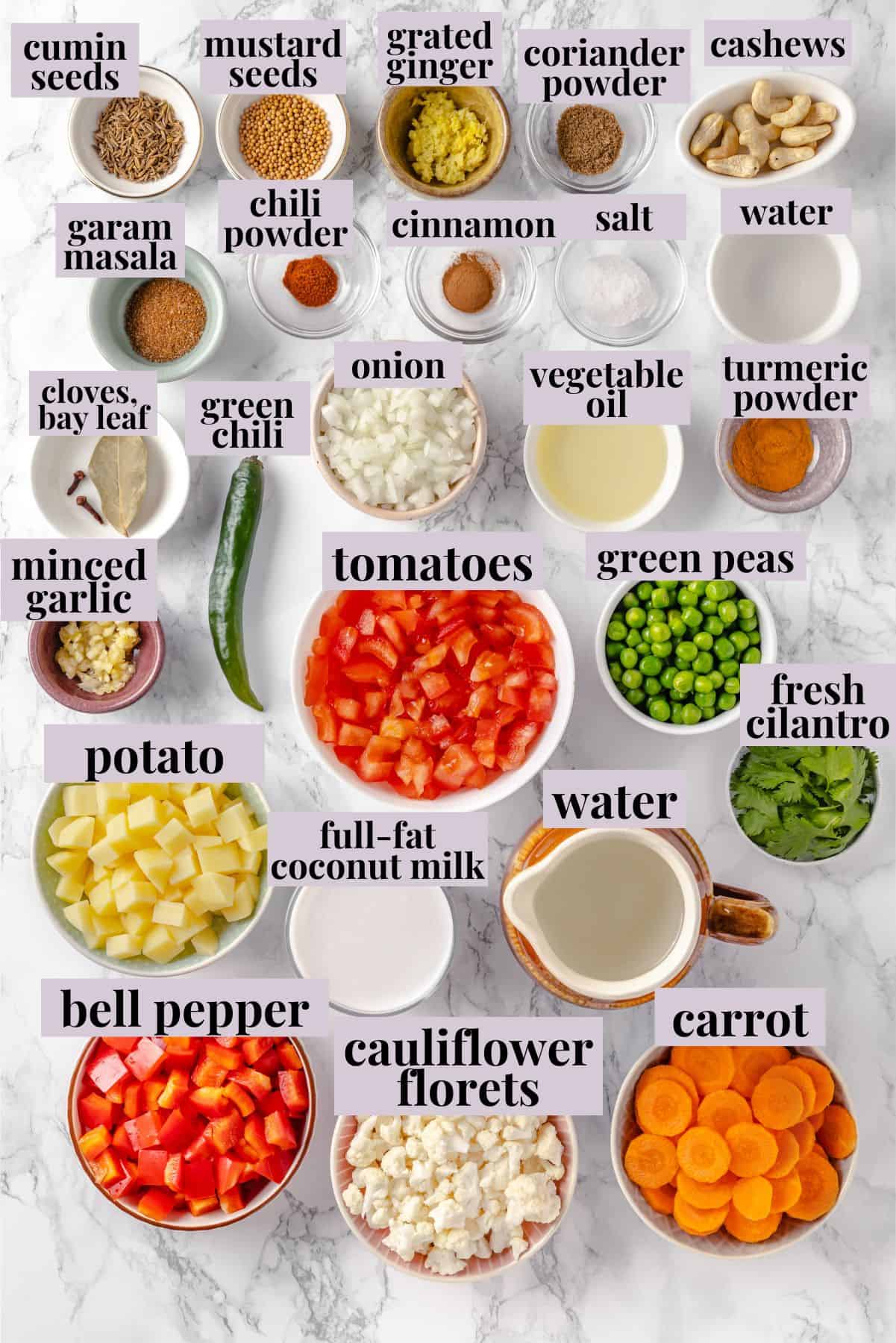
Notes on Ingredients
Scroll down to the recipe card to find the ingredient quantities and recipe instructions.
Vegetables:
- Carrot
- Bell pepper – You can use any colour you like. Green bell pepper has a sharper flavour, while other varieties are sweeter.
- Potato – I like Yukon gold or russet potatoes for making vegetable korma.
- Cauliflower – Florets from a head of cauliflower, or simply buy a bag and save yourself some prep time.
- Green peas – Use fresh or frozen for this recipe.
- Tomatoes
- Onion
Paste:
- Cashews – Soak your cashews so they blend smoothly.
- Green chili – Discard the seeds if you prefer a milder flavour.
- Ginger and garlic – These build flavour in the sauce.
- Water
Spices:
- Mustard seeds and cumin seeds – The seeds infuse flavour into the oil.
- Cloves and bay leaf – The bay leaf should be removed before serving. The cloves should also be removed, but sometimes it’s hard to fish them out of a big pot. I usually just take them out when I find them in my bowl as I’m enjoying the curry.
- Ground spices – Coriander powder, garam masala, turmeric powder, cinnamon, and chili powder.
- Kosher salt
For cooking:
- Vegetable oil – Or another oil you like to use for cooking.
- Water
- Coconut milk – Use full-fat coconut milk for rich and creamy vegetable korma.
- Cilantro – For garnish.
How to Make Vegetable Korma
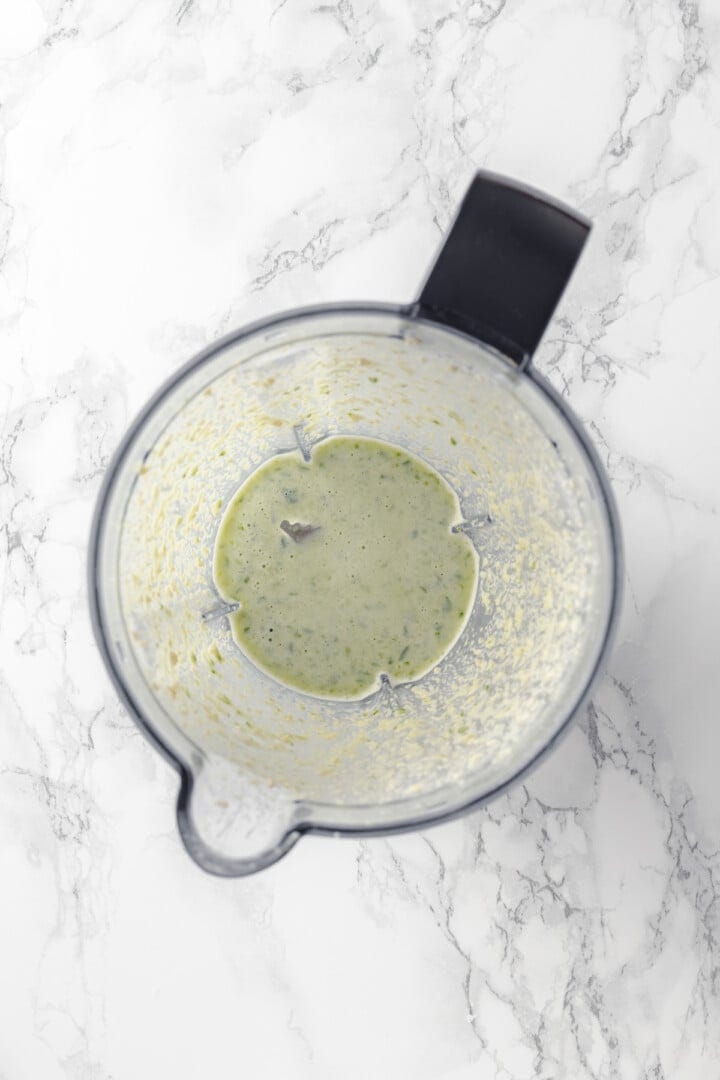
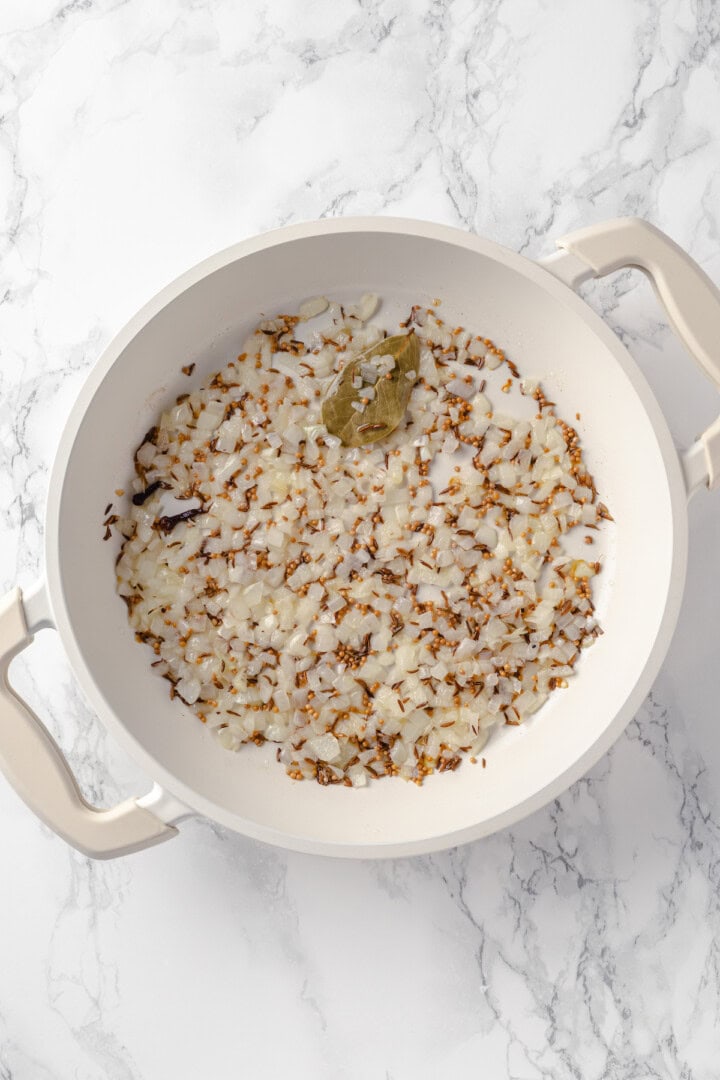
- Make the paste. Blend the soaked cashews with the green chili, garlic, ginger, and water.
- Cook the aromatics. Heat the oil in a skillet or pot. Add the seeds, cloves, and bay leaf and cook for 30 seconds. Sauté the onion for 5 minutes, then add the remaining spices and cook for 30 seconds, or until fragrant.
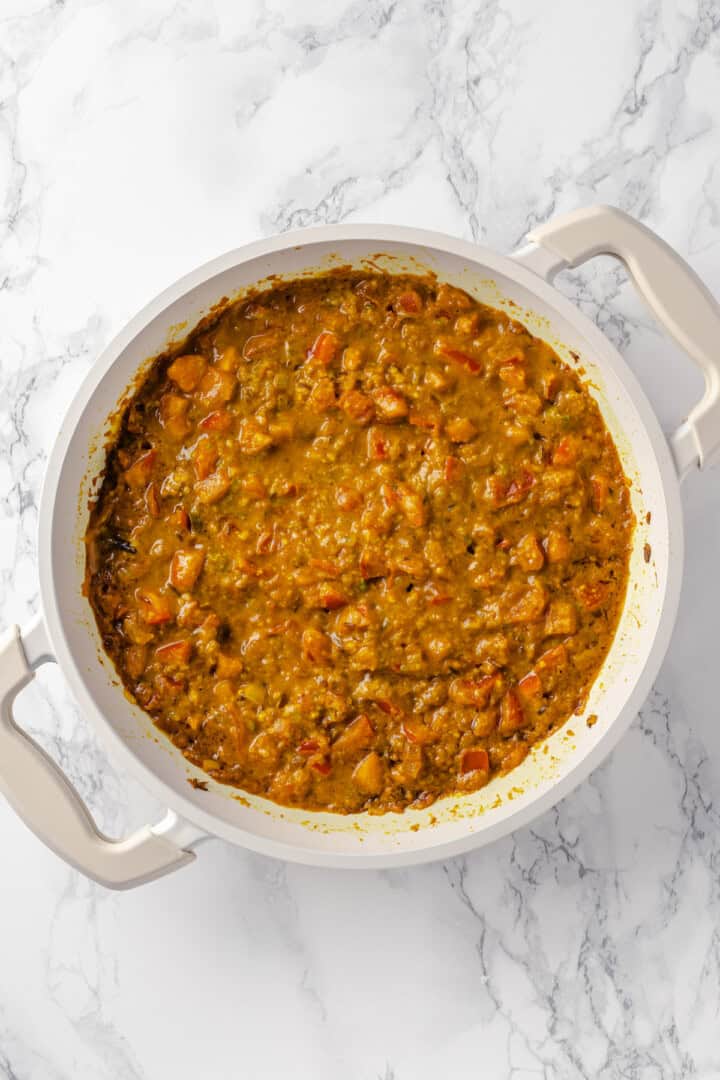
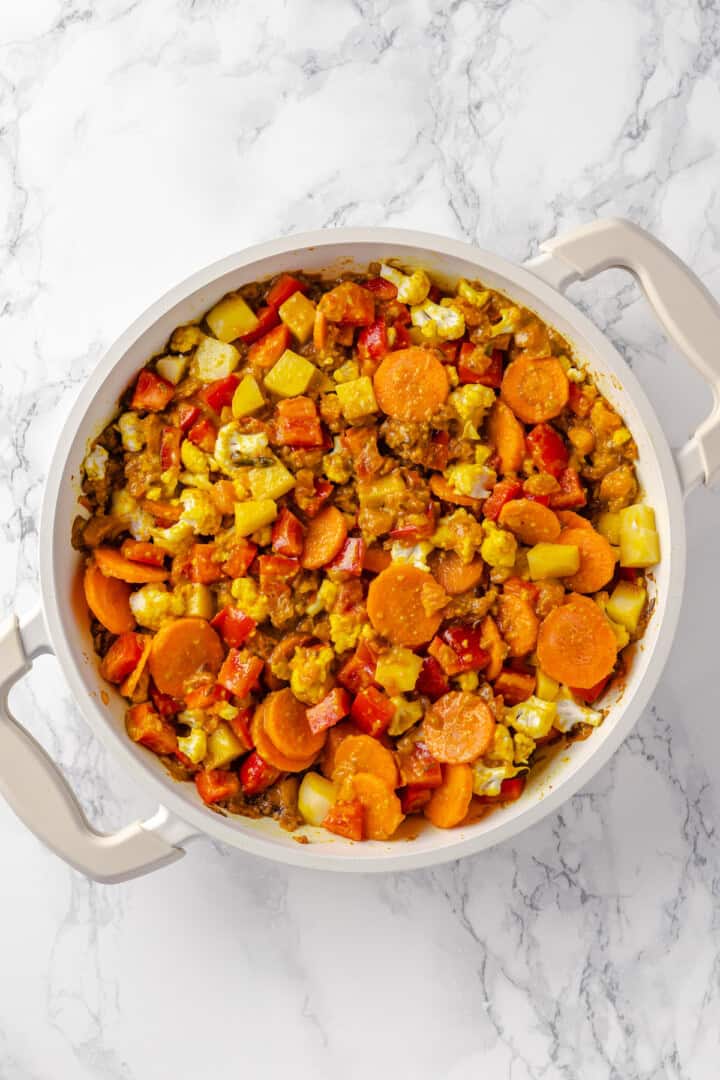
- Add the tomatoes, salt, and paste. Stir in the tomatoes, salt, and cashew paste, and cook for a minute.
- Add the vegetables. Stir in the carrots, potatoes, bell pepper, and cauliflower.
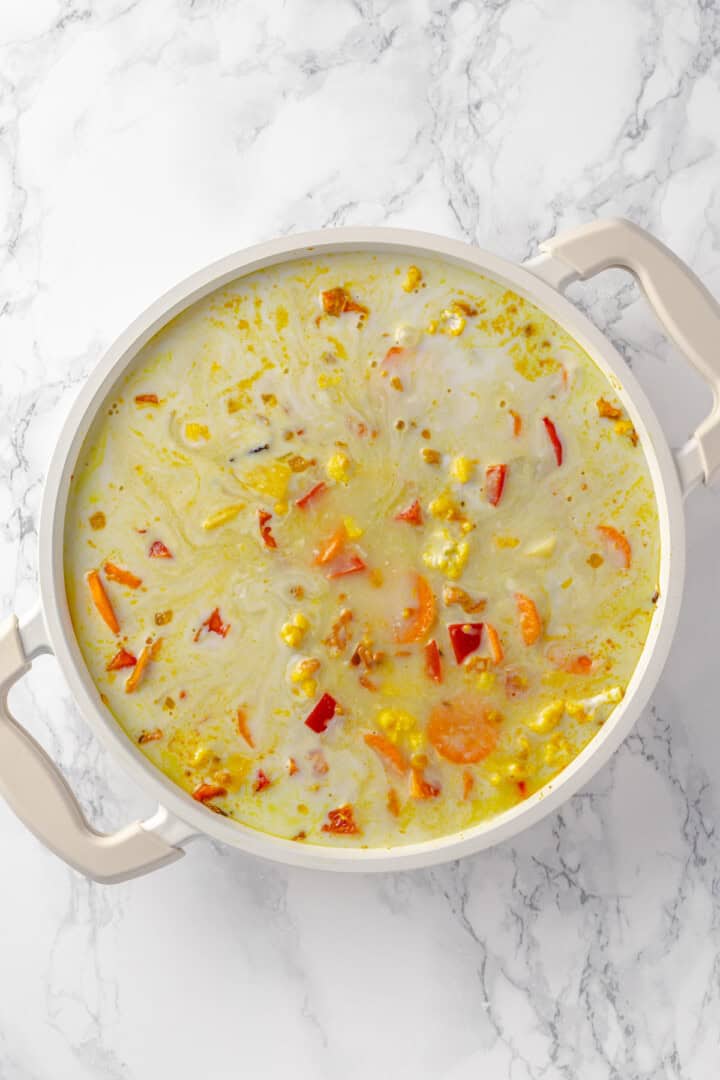
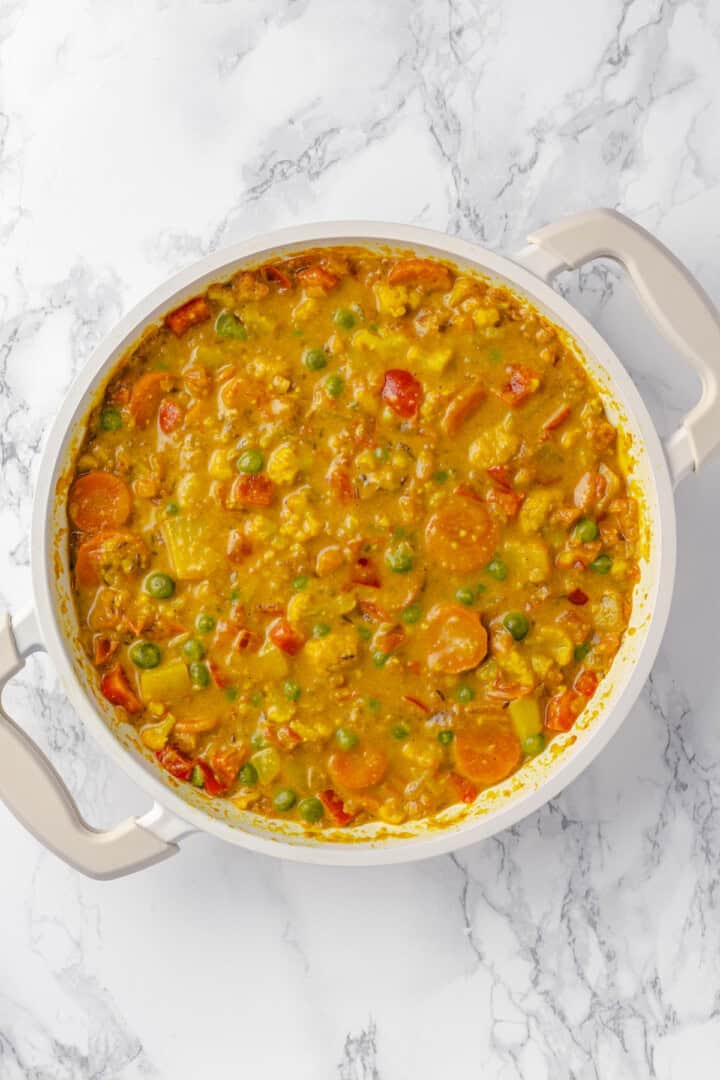
- Simmer. Pour in the coconut milk and water. Stir and bring to a simmer, then reduce the heat to low and cook covered for 15 to 20 minutes, or until the veggies are tender. Stir in the peas during the last 3 minutes of cooking time.
- Finish. Season the vegetable korma to taste, garnish with cilantro, and serve.
Tips and Variations
- Prep ahead. Chop all your vegetables before you get started. The first few steps of the recipe move quickly, so once you start warming the spices in the oil, you’ll need all the remaining ingredients prepped and ready to go.
- Don’t overcook the vegetables. You want the vegetables to be quite tender in korma, but not to the point where they’re falling apart and turning to mush.
- Add protein. You can stir in pan-fried extra-firm tofu or even chickpeas to incorporate some extra protein. Or make vegan chicken korma with my vegan chicken recipe.
- Swap out the coconut milk. You can use vegan heavy cream if you have a coconut allergy.
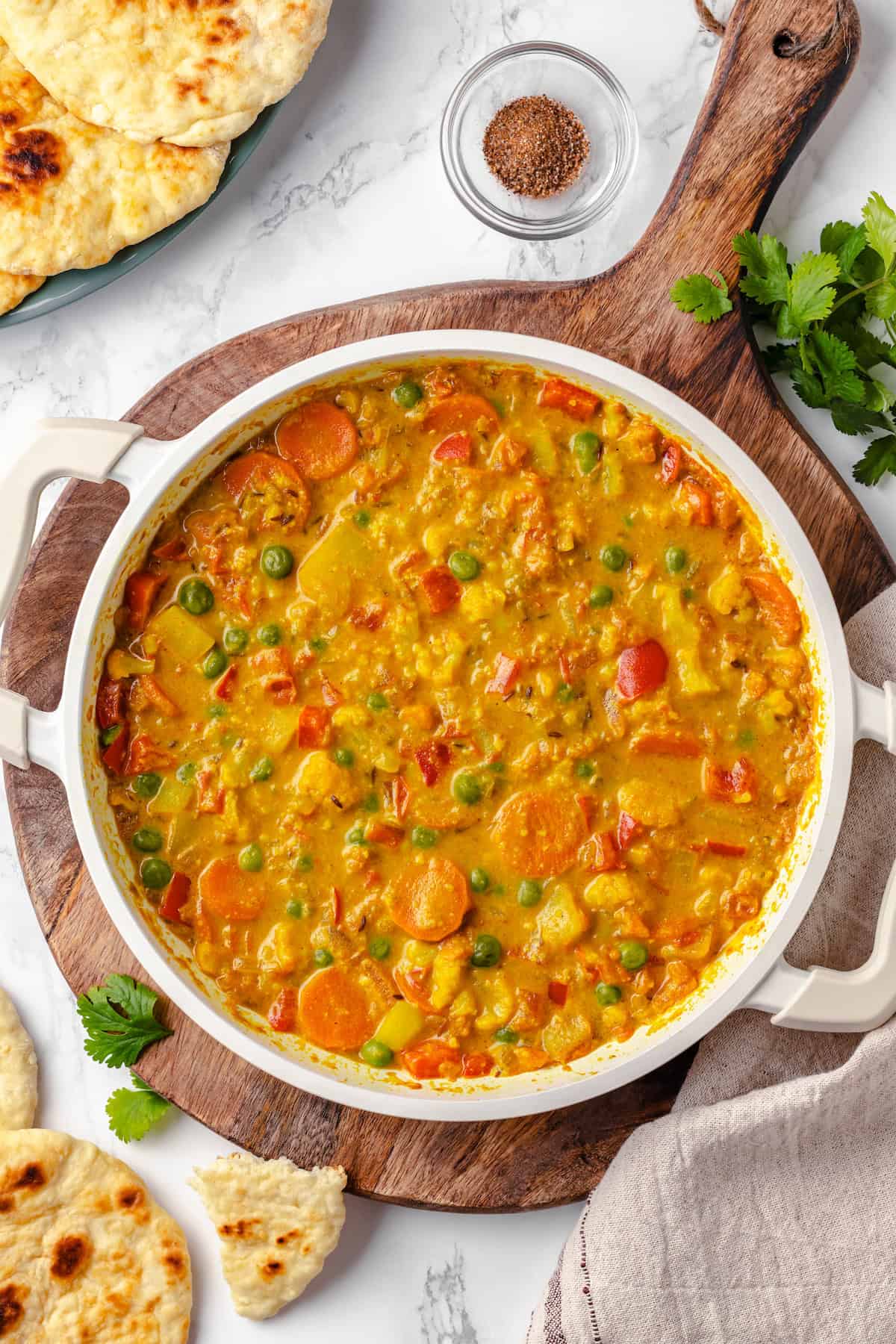
What to Serve With Vegetable Korma
Garlic naan is always a good idea with Indian food, as is vegetable biryani. You can also serve the vegetable korma over cauliflower rice or cooked quinoa.
How to Store and Reheat Leftovers
- Refrigerator: Store any leftovers in an airtight container in the refrigerator for up to 3 days.
- Freezer: Transfer the vegetable korma to a freezer-safe container or bag. It will keep well for up to 3 months. When ready to eat, thaw overnight in the refrigerator.
- To reheat: Warm the vegetable korma in a saucepan over medium heat. Alternatively, you can microwave it until it’s warmed through.
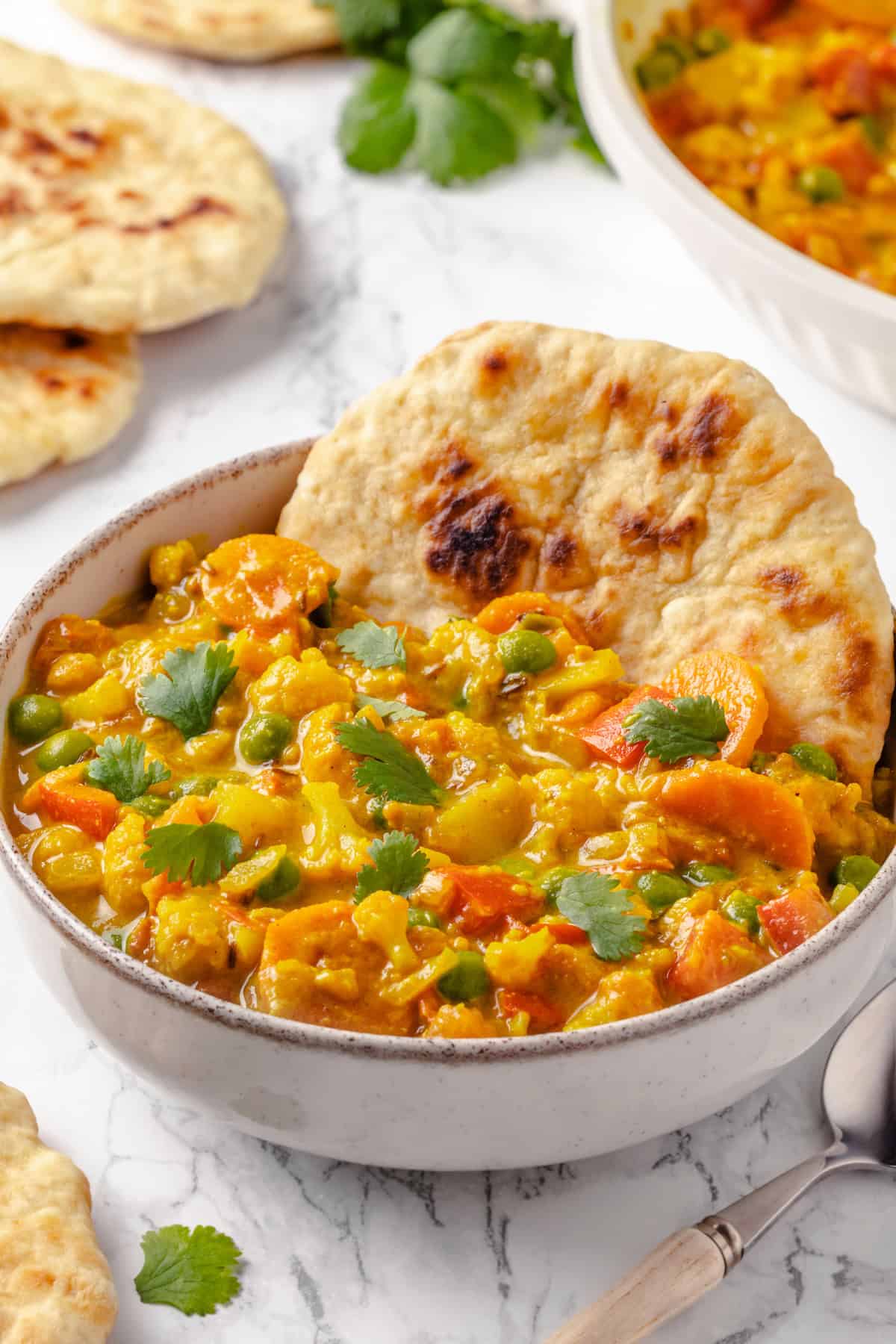
More Vegan Indian Recipes
Enjoy friends! If you make this vegetable korma, please snap a photo and tag #jessicainthekitchen on Instagram! We’d also love it if you would leave a comment below, and give the recipe a rating! Thanks so much!
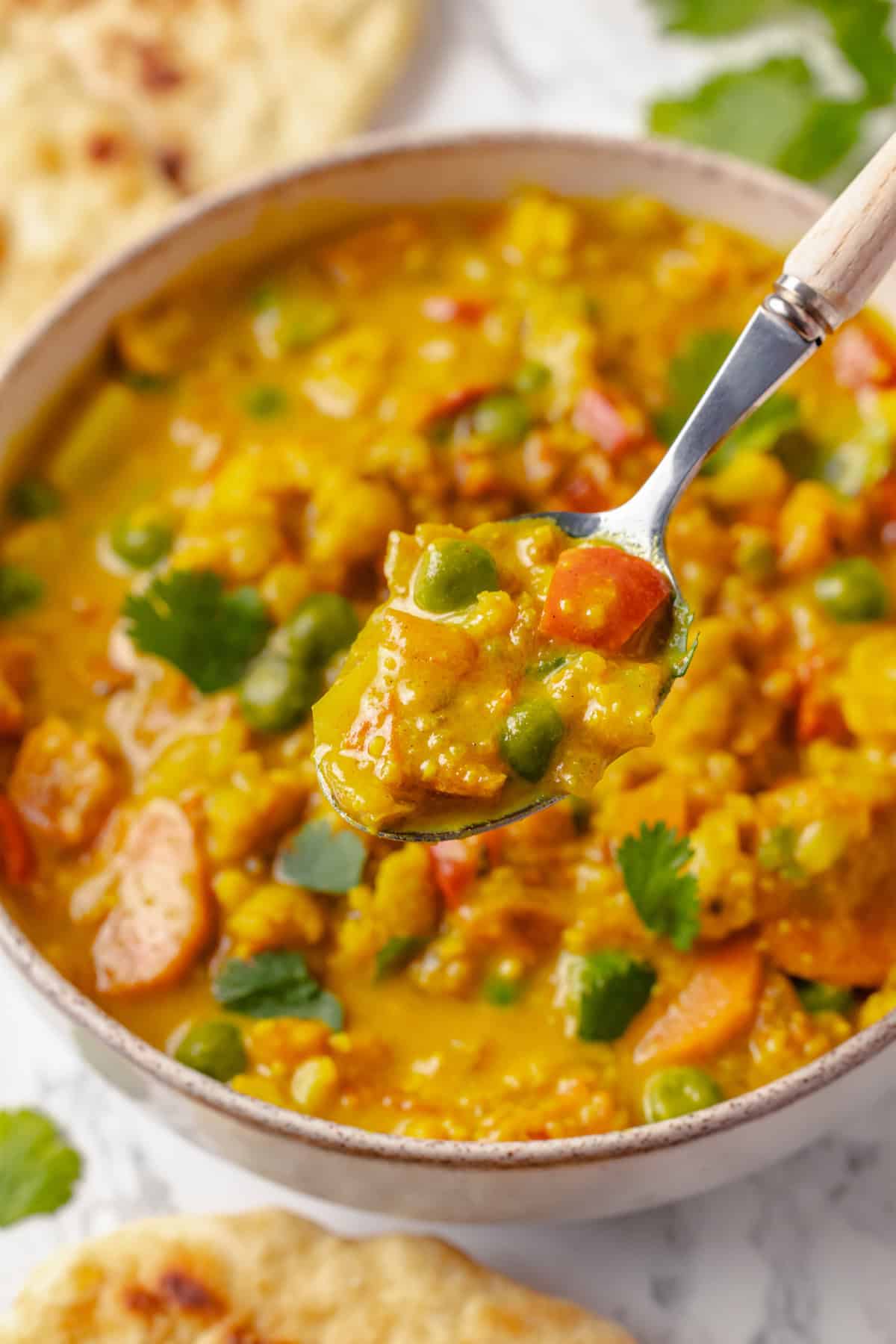
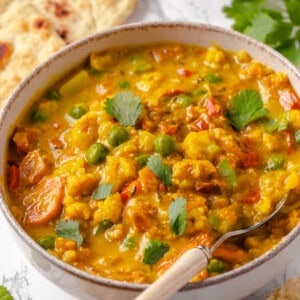
Vegetable Korma
Ingredients
Vegetables:
- 1 medium carrot, sliced
- 1 medium bell pepper, chopped
- 1 medium potato, diced
- ¾ cup cauliflower florets
- ½ cup green peas, fresh or frozen
- 2 medium tomatoes, finely chopped
- 1 medium onion, finely chopped
Paste:
- 10 cashews, soaked for 15 minutes
- 1 green chili, discard seeds if you don’t want it too spicy
- 1 inch ginger, grated
- 2 garlic cloves, minced
- ⅓ cup water, 60ml
Spices:
- 1 teaspoon mustard seeds
- 1 teaspoon cumin seeds
- 2 cloves
- 1 bay leaf
- ½ teaspoon coriander powder
- ½ teaspoon garam masala
- ½ teaspoon turmeric powder
- ¼ teaspoon cinnamon
- ¼ teaspoon chili powder, optional for a spicy korma
- 1 teaspoon kosher salt
- 2 tablespoons vegetable oil
- 1 ½ cups water, 360ml
- 1 cup full fat coconut milk, from a can, 240ml
- fresh cilantro, for garnish
Instructions
- Wash and chop all vegetables, and set them aside.
- Make the paste: Blend soaked cashews with green chili, garlic, ginger, and water until smooth.
- In a large skillet or pot, heat the vegetable oil over medium heat.
- Add the cumin and mustard seeds, cloves, and bay leaf, and let them sizzle for about 30 seconds until aromatic.
- Add the chopped onion and sauté until it softens (about 5 minutes).
- Add the rest of the spices and cook for 30 seconds, stirring.
- Stir in the chopped tomatoes, salt, and cashew paste. Cook for about 1 minute, stirring continuously to prevent burning.
- Add the carrots, potatoes, bell pepper, and cauliflower. Stir well to coat them in the spice mixture.
- Add coconut milk and water just to cover the vegetables, about 1 1/2 cups. Stir everything together.
- Bring the mixture to a gentle simmer, then reduce the heat to low. Cover, and let it cook for about 15-20 minutes, or until the vegetables are tender.
- Add green peas during the last 3 minutes of cooking.
- Taste and adjust salt as needed.
- Garnish with fresh cilantro before serving.
- Serve with fresh naan bread.
Notes
- Refrigerator: Store any leftovers in an airtight container in the refrigerator for up to 3 days.
- Freezer: Transfer the vegetable korma to a freezer-safe container or bag. It will keep well for up to 3 months. When ready to eat, thaw overnight in the refrigerator.
- To reheat: Warm the vegetable korma in a saucepan over medium heat. Alternatively, you can microwave it until it’s warmed through.
Disclaimer: Although jessicainthekitchen.com attempts to provide accurate nutritional information, kindly note that these are only estimates. Nutritional information may be affected based on the product type, the brand that was purchased, and in other unforeseeable ways. Jessicainthekitchen.com will not be held liable for any loss or damage resulting for your reliance on nutritional information. If you need to follow a specific caloric regimen, please consult your doctor first.



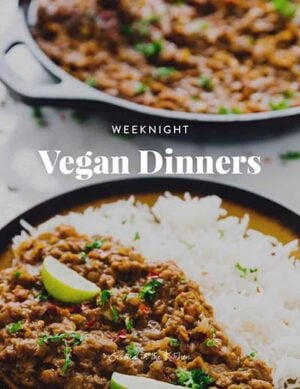
Hi Jessica. Can I substitute soy milk for coconut? I have genetically high cholesterol even as a vegan. Thanks. Sita
Hi Sita,
Yes you can substitute it! Enjoy so much!
This looks amazing! I’m going to make it in the Instant pot and let you know how it goes!
Instant Pot sounds amazing! Enjoy so much Judy!
This looks amazing. Looks so creamy, definitely one I will be making this week. Love your recipes!
Thanks so much Tammie! I hope you get to make it, and love it!!
Hi again. I am going to make this tonight for dinner and have cumin powder and mustard powder. Will they work? I don’t want to buy the seeds till I try the recipe. What do you think? Thank you! And Happy New Year!
Hi Sita,
They will work! The flavour might just be a bit less intense. Hope that helps, enjoy!
Oooooowe!!! This is one of the best recipes ever. I know this sounds like exaggeration. But you won’t find out till you try it. And I recommend you trying it. My family devoured it. And we don’t just eat anything. So ladies and gentlemen, if you get the opportunity. Maybe I should say when you make the opportunity you will be pleasantly pleased.